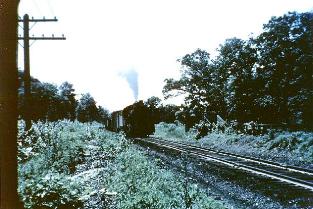 An eastbound behind one of the monster 90 class consolidations approaches the west end of the Warwick yard to start the parade.
An eastbound behind one of the monster 90 class consolidations approaches the west end of the Warwick yard to start the parade.
 An eastbound behind one of the monster 90 class consolidations approaches the west end of the Warwick yard to start the parade.
An eastbound behind one of the monster 90 class consolidations approaches the west end of the Warwick yard to start the parade.
 The train pulls into the yard, watched by the brakeman at the Main switch. A westbound behind one of the 10 class 4-8-2's waits on the Main for it to clear, and to the right of it, 2-8-2 #72, today's west end drill engine, waits its turn to get to work.
The train pulls into the yard, watched by the brakeman at the Main switch. A westbound behind one of the 10 class 4-8-2's waits on the Main for it to clear, and to the right of it, 2-8-2 #72, today's west end drill engine, waits its turn to get to work.
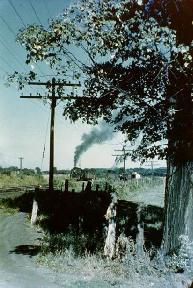 The eastbound has been yarded, clearing the main for the westbound behind #10; the 4 year old Mountain has started moving its train.
The eastbound has been yarded, clearing the main for the westbound behind #10; the 4 year old Mountain has started moving its train.
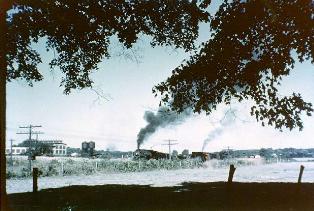 This wide shot shows the shops, roundhouse, stores building, and twin water tanks to the left, and to the right, the B&O transfer shed and the 'white house' on the RIP track. The 72 waits for the westbound to clear, when it will start drilling the newly-arrived eastbound.
This wide shot shows the shops, roundhouse, stores building, and twin water tanks to the left, and to the right, the B&O transfer shed and the 'white house' on the RIP track. The 72 waits for the westbound to clear, when it will start drilling the newly-arrived eastbound.
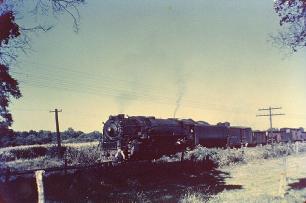 #10 is clearing the west yard throat, accompanied by the brakeman, ready to throw the Main switch behind it for the 72 to begin working on the eastbound's consist.
#10 is clearing the west yard throat, accompanied by the brakeman, ready to throw the Main switch behind it for the 72 to begin working on the eastbound's consist.
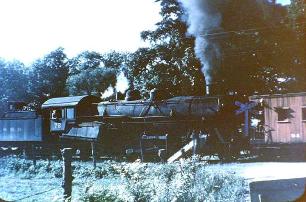 The drill begins its task; it has pulled the consist west out of the yard track, and appears to be shoving the train back into the yard to a different track, part of the blocking prodedure.
The drill begins its task; it has pulled the consist west out of the yard track, and appears to be shoving the train back into the yard to a different track, part of the blocking prodedure.
Until sometime in the fifties, there were two Warwick drill jobs, one working the west (Pelton Road) end of the yard, the other working the east (Elm Street) end. By the time that the "A Day in the Life... (1961)" article was written, the west end drill had been eliminated.
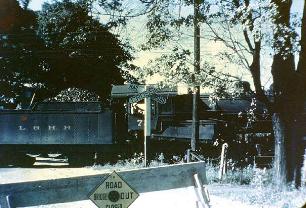 The 72 continues shoving into the yard. The sign on the sawhorse refers to the bridge over the Wawayanda creek just beyond the crossing. This crossing is currently busy County Rt. 1; at the time, it was just plain old Pelton Road, basically a dirt road running from Hathorn Road to West St. Extension. It served a couple of dairy farms and some half-dozen houses; as such, it only merited a crossbuck warning sign. In the early seventies, Orange County constructed the present-day County 1, including Pelton Road as a part of it. The name survives as the crossing on the railroad; it is now the change of ownership point between the New York Susquehanna & Western and the Norfolk Southern (ex Conrail) Hudson Secondary (the 'PR' of present day Form D's).
The 72 continues shoving into the yard. The sign on the sawhorse refers to the bridge over the Wawayanda creek just beyond the crossing. This crossing is currently busy County Rt. 1; at the time, it was just plain old Pelton Road, basically a dirt road running from Hathorn Road to West St. Extension. It served a couple of dairy farms and some half-dozen houses; as such, it only merited a crossbuck warning sign. In the early seventies, Orange County constructed the present-day County 1, including Pelton Road as a part of it. The name survives as the crossing on the railroad; it is now the change of ownership point between the New York Susquehanna & Western and the Norfolk Southern (ex Conrail) Hudson Secondary (the 'PR' of present day Form D's).
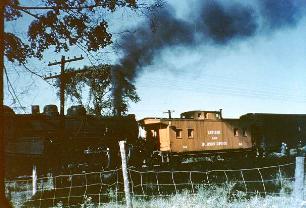 Continuing pushing into the yard. A nice view of caboose 94. The 90 class cabooses were homebrews, converted by the road in the late thirties from former milk cars. They largely replaced the 80 class 4 wheel 'bobbers', which dated to the first decade of the century. The 90 class, in turn, were replaced by the Reading-built 10 class, which had been on the property for nearly six years by this time.
Continuing pushing into the yard. A nice view of caboose 94. The 90 class cabooses were homebrews, converted by the road in the late thirties from former milk cars. They largely replaced the 80 class 4 wheel 'bobbers', which dated to the first decade of the century. The 90 class, in turn, were replaced by the Reading-built 10 class, which had been on the property for nearly six years by this time.
In the fifties, the 94 was parked on the tail end of the scale track at the other end of the yards, and served as the yard office until the late sixties; in that role, it was known as the 'Club 94'.
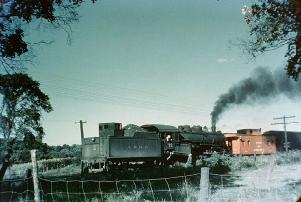 Pushing further into the yard. Notice the tender 'doghouse'. The road applied them to the 70, 80, and 90 class engines. The doghouse was a shelter for the head-end brakeman, used by several railroads.
Pushing further into the yard. Notice the tender 'doghouse'. The road applied them to the 70, 80, and 90 class engines. The doghouse was a shelter for the head-end brakeman, used by several railroads.
Normally, the head-end brakeman would ride in the cab, usually on a jump seat behind the fireman's seat. With the L&HR's 70 and 90 classes, the end cab was squeezed around the end of the wide Wooten firebox. Space inside the cab was at a premium, at best. The doghouse allowed one man to be moved out of the cab, leaving more room there for the engineer and fireman, and provided the brakeman with more room. The 'box' was heated in winter with a steam line from the engine.
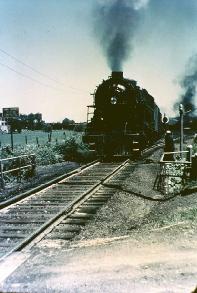 Another westbound departing Warwick. This one may be out of sequence- without looking at Bill's original slide numbers (a piece of data I didn't record when I made the copies), I can't say for sure...
Another westbound departing Warwick. This one may be out of sequence- without looking at Bill's original slide numbers (a piece of data I didn't record when I made the copies), I can't say for sure...
In any case, an interesting shot. The train may or may not be L&HR, but the locomotive isn't. It appears to be a Lackawanna 2100 series Mikado, indicating the train is bound for Port Morris. Before the Erie-Lackawanna merger, the DL&W used a trackage-rights agreement with the L&HR to access the Maybrook yard and New England traffic. Until the merger, Lackawanna power was a common sight through Warwick.